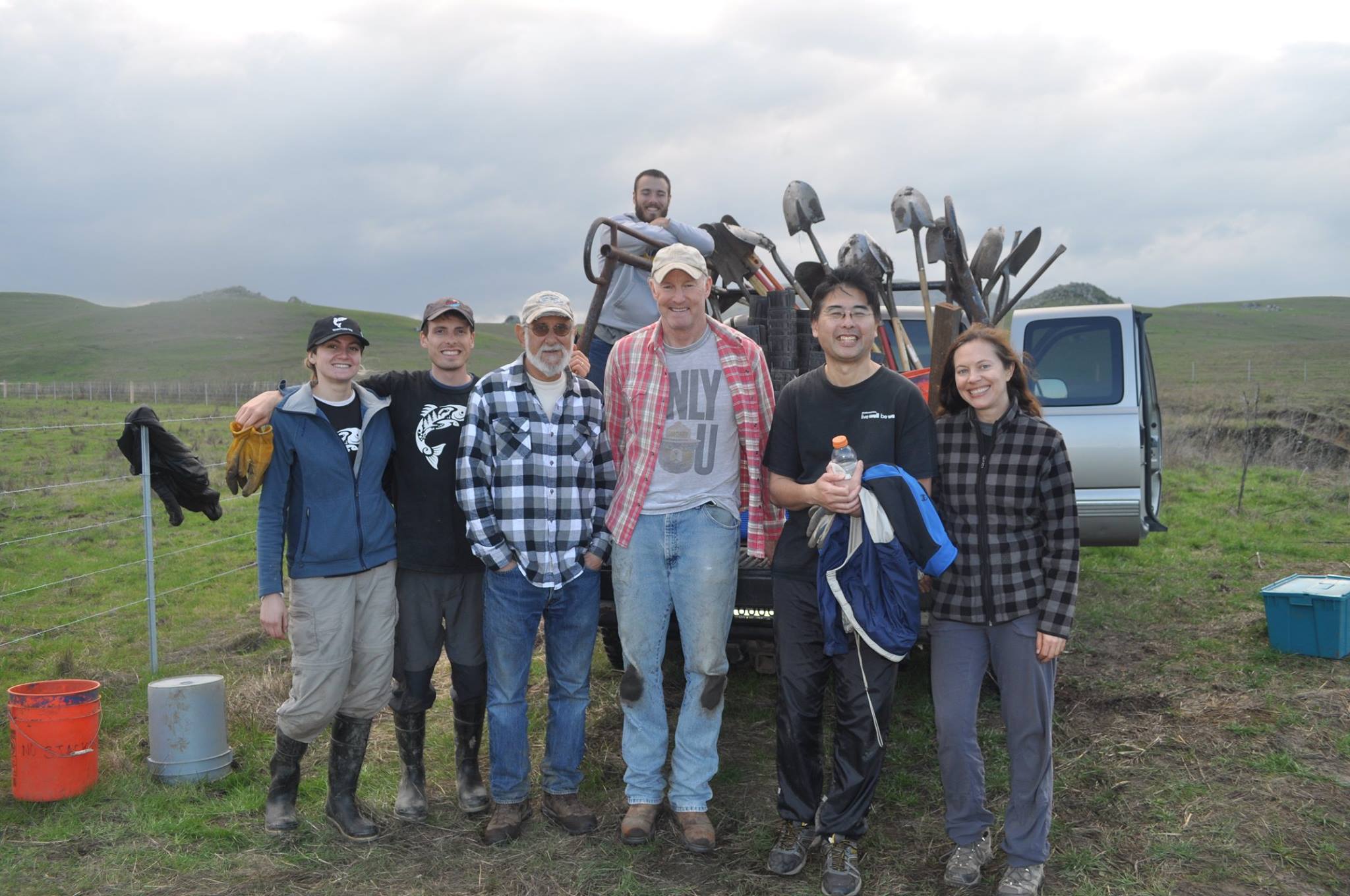
About 25 volunteers helped plant 325 redwood trees and companion plants on two properties in Nicasio to restore diverse, resilient ecosystems. The effort is part of 10,000 Redwoods, a project that aims to create a local carbon sink in the San Francisco Bay Area to combat climate change. | Photo by Turtle Island Restoration Network
NICASIO—Staff and volunteers of Turtle Island Restoration Network (TIRN) planted more than 300 redwood trees in Nicasio in January, expanding an effort to fight climate change and bring back endangered California redwood forests to Marin County, an ecosystem that has been reduced by 95 percent due to logging and development.
About 25 volunteers helped plant 325 redwood trees and companion plants on two properties in Nicasio to restore diverse, resilient ecosystems. The effort is part of 10,000 Redwoods, a project that aims to create a local carbon sink in the San Francisco Bay Area to combat climate change.
“We’re excited to expand our 10,000 Redwoods program into the nearby Nicasio Creek watershed, which was once dominated by redwoods that were more than 1,000 years old,” said Audrey Fusco, Nursery Manager of Turtle Island Restoration Network. “The seeds are collected and cut locally, and grown in our native plant nursery until they are ready for out-planting, so the redwoods we are planting are the local ecotype for the San Geronimo Valley and nearby areas such as Nicasio Valley.”
Due to overharvesting, only five percent of the original old-growth coast redwood trees remain, and they are listed as endangered by the International Union for Conservation of Nature’s Red List of Threatened Species. The loss of coastal redwoods in California also impacts critically endangered Coho salmon and other species. In 2015, TIRN launched the 10,000 Redwoods program to coincide with the Paris Agreement.

Petaluma resident Christian Uyeno was among volunteers who helped plant redwood trees in Nicasio, California in an effort to fight climate change and restore local ecosystems. | Photo by Turtle Island Restoration Network
“Redwoods are a symbol of California and the conservation movement,” said Todd Steiner, Turtle Island Restoration Network Executive Director. “I think John Steinbeck said it best in his famous quote, ‘The redwoods, once seen, leave a mark or create a vision that stays with you always…The feeling they produce is not transferable. From them comes silence and awe. It’s not only their unbelievable stature, nor the color which seems to shift and vary under your eyes, no, they are not like any trees we know, they are ambassadors from another time.’”
Because they are fast growing, massive, long-lived, rot resistant, and easy to cultivate, planting redwoods are an important tool and critical in the fight against climate change. Redwood trees store more carbon per hectare than any other tree on Earth in their massive trunks and in their root system. Coastal redwood trees sequester triple the above ground carbon of any other type of tree, making them a key player in mitigating climate change. In addition to helping to sequester carbon and reclaiming land for redwood forest, the trees planted in Nicasio will help to stabilize an eroding creek bank and diversify habitat for wildlife.
With the help of volunteers, interns, and elementary school students in Marin County, redwood seeds have been collected and germinated, and seedlings have been nurtured in SPAWN’s native plant nursery for three to four years. The volunteers who helped plant out these young trees ranged from Mel Wright, a 75-year-old Woodacre resident and regular TIRN volunteer, to a Fremont Elementary School student who came to help her mom plant trees. One middle school student came accompanied by her father, who originally planned to come along to support his daughter’s interest but then decided to plant one tree. Rather than stopping at one, he continued to plant all day. He later said this was the first time he’d ever planted a tree and he will come back to help again.
“Someday, centuries into the future, these trees will be towering giants that will make future generations stare up in awe,” said Preston Brown, TIRN’s Watershed Conservation Director.
Turtle Island Restoration Network is hosting two additional redwood planting events in February in Woodacre and Lagunitas. If you are interested in volunteering to help fight climate change and restore crucial habitat, please email Preston Brown at preston@seaturtles.org for more details and to RSVP.

With the help of volunteers, interns, and elementary school students in Marin County, redwood seeds have been collected and germinated, and seedlings have been nurtured in TIRN’s Native Plant Nursery for three to four years. | Photo by Turtle Island Restoration Network

Preston Brown, TIRN’s Director of Watershed Conservation, demonstrates how to plant redwood trees in Nicasio. | Photo by Turtle Island Restoration Network

About 25 volunteers helped plant 325 redwood trees and companion plants on two properties in Nicasio to restore diverse, resilient ecosystems. The effort is part of 10,000 Redwoods, a project that aims to create a local carbon sink in the San Francisco Bay Area to combat climate change. | Photo by Turtle Island Restoration Network

Arcata resident Aris Owensby was among volunteers who helped plant redwood trees in Nicasio, California in an effort to fight climate change and restore local ecosystems. | Photo by Turtle Island Restoration Network

A group of volunteers learn how to plant redwoods in Nicasio, California. The efforts will help create a local carbon sink in the San Francisco Bay Area to help fight climate change. | Photo by Turtle Island Restoration Network




